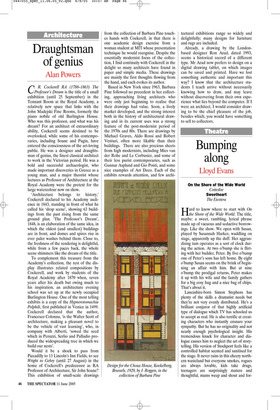Draughtsman of genius
Alan Powers
CR. Cockerell RA (1788–1863) The Professor’s Dream is the title of a small exhibition (until 25 September) in the Tennant Room at the Royal Academy, a relatively new space that links with the John Madejski Fine Rooms, formerly the piano nobile of old Burlington House. Who was this professor, and what was his dream? For an architect of extraordinary ability, Cockerell seems destined to be overlooked, while some of his contemporaries, including Soane and Pugin, have entered the consciousness of the art-loving public. He was a designer and draughtsman of genius, the finest classical architect to work in the Victorian period. He was a bold and successful archaeologist, who made important discoveries in Greece as a young man, and a major theorist whose lectures as Professor of Architecture at the Royal Academy were the pretext for the large watercolour now on show.
‘Architecture belongs to history,’ Cockerell declared to his Academy audience in 1843, standing in front of what he called his ‘drop scene’, showing 63 buildings from the past rising from the same ground plan. ‘The Professor’s Dream’, 1848, is an elaboration of the same idea, in which the oldest (and smallest) buildings are in front, and domes and spires rise in ever paler washes behind them. Close to, the freshness of the rendering is delightful, while from a few paces back, the whole scene shimmers like the dream of the title.
To complement this treasure from the Academy’s collection, the rest of the display illustrates related compositions by Cockerell, and work by students of the Royal Academy after 1870 when, seven years after his death but owing much to his inspiration, an architecture evening school was set up at the newly occupied Burlington House. One of the most telling exhibits is a copy of the Hypnerotomachia Polphili, first published in Venice in 1499. Cockerell declared that the author, Francesco Colonna, ‘is the Walter Scott of architecture, making a pleasant novel to be the vehicle of vast learning’, who, in company with Alberti, ‘sowed the seed which in Peruzzi, Serlio and Palladio produced the widespreading tree in which we build our nests’.
Would it be a shock to pass from Piccadilly to 13 Lincoln’s Inn Fields, to see Wright to Gehry (until 27 August) in the home of Cockerell’s predecessor as RA Professor of Architecture, Sir John Soane? This exhibition of small-scale drawings from the collection of Barbara Pine touches hands with Cockerell, in that there is one academic design exercise from a woman student at MIT whose presentation technique he would recognise. Despite the essentially modernist focus of the collection, I find continuity with Cockerell in the delight so many architects have found in paper and simple media. These drawings are mainly the first thoughts flowing from the hand, and each evokes its author.
Based in New York since 1963, Barbara Pine followed no precedent in her collecting, approaching living architects who were only just beginning to realise that their drawings had value. Soon, a lively market developed, and the strong interest both in the history of architectural drawing and in its current uses was a strong feature of the post-modernist period of the 1970s and 80s. There are drawings by Michael Graves, Aldo Rossi and Robert Venturi, often more likable than their buildings. There are also precious sheets from high modernists, including Mies van der Rohe and Le Corbusier, and some of their less purist contemporaries, such as Gunnar Asplund and Gio Ponti, and some nice examples of Art Deco. Each of the exhibits rewards attention, and few archi tectural exhibitions range so widely and delightfully; many designs for furniture and rugs are included.
Already, a drawing by the Londonbased designer Ron Arad, dated 1993, seems a historical record of a different type. Mr Arad now prefers to design on a digital drawing tablet, on which images can be saved and printed. Have we lost something authentic and important this way? I know that the architecture students I teach arrive without necessarily knowing how to draw, and may leave without discovering from their own experience what lies beyond the computer. If I were an architect, I would consider drawing to be the chief pleasure of the job, besides which, you would have something to sell to collectors.


















































 Previous page
Previous page